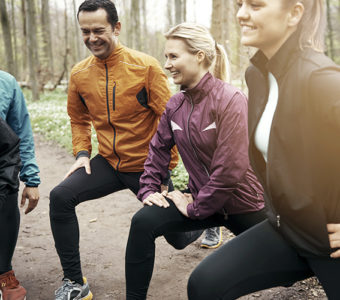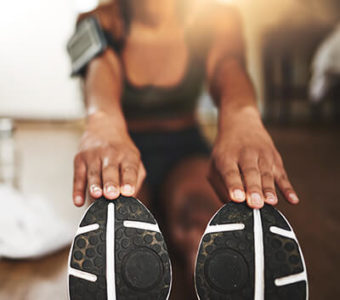Staying safe while running outdoors requires awareness and preparation, especially when running in the dark, busy areas and hot or cold weather. We have running safety advice, practical tips and strategies from an expert to keep you confidently and safely pounding the pavement in any environment.
“Running is a great way to spend time outside and get a great workout,” says Amy Harrison, athletic trainer and OhioHealth Athletic Performance Clinic coordinator. “You don’t have to miss getting a run in, even when the temperature changes if you prepare for the weather and take a few precautions.”
Safe running practices
One of the first tenets of running safety is to let someone know where and when you will be running. You can also enable safety alerts on your phone or smartwatch in an emergency. Harrison says runners should also carry their ID or Road ID (a shoe tag with contact information).
When running on or near roads, it’s important to follow a few basic rules. That includes running on the left side, against traffic, so that drivers can easily spot you and only crossing the street at intersections. Harrison suggests sticking to wide roads with a big shoulder that provides plenty of space to distance yourself from traffic.
“In addition to making eye contact with drivers before stepping into the road, I give them a little wave to make sure we’re on the same page,” says Harrison. “It’s also important to avoid running in areas with a lot of traffic. Running trails, pedestrian or bike paths are a good option during rush hour or if you live near a school and run during drop off and pick up times.”
Harrison explains that pedestrian and bike trails work differently than road running. In general, you run on the right side with the flow of foot and bicycle traffic and pass on the left. She says it’s important to be vocal on a running trail so that people know where you are, as well as your intentions.
Nighttime running tips
Running in the dark or in conditions that make it difficult to see can put you at risk for falls or ankle injuries. When running at night, Harrison recommends sticking to familiar routes or neighborhoods and parks with sidewalks and streetlights to help guide your way. Nighttime is not great for trail running because it’s so easy to trip over exposed tree roots or lose your footing on loose rocks.
Poor visibility doesn’t only happen at night. Harrison recommends you avoid hilly roads when there’s a lot of traffic because it can create a dangerous situation. Drivers can also have a hard time spotting runners at dawn or dusk when the sun is in their eyes. She suggests running north or south routes at sunrise or sunset as an added safety measure.
Harrison says that while reflective or light-colored clothing is good, lights are a better choice to help drivers, cyclists and other runners spot you more easily.
“There is a lot of running safety gear available, from headlamps to lighted belts,” says Harrison. “The bottom line is that you want to be as visible as possible when running in the dark, at dusk or dawn.”
Running in every type of weather
Any time you run outdoors, it’s important to be prepared and dressed appropriately for the weather. A few simple steps can keep you safe and comfortable even if temperatures are scorching, freezing or somewhere in between.
Hot weather running safety
Before setting out on a run in the summertime, Harrison suggests checking your local heat index and planning your run for the coolest time of day.
Hydrating before you run in the heat is crucial, and if you run for more than an hour it’s important to replenish the electrolytes that you lose from sweating. It’s a good idea to know where you can find water, such as a drinking fountain, along your route or carry water with you.
“Water is so important when it gets hot, especially for runners. Be sure to drink plenty of it,” says Harrison. “If it’s especially hot outside, I plan my route so that I can run through sprinklers if I know when they will be running.”
When the temperatures rise, wicking fabrics are a runner’s best friend. Applying plenty of sunscreen rather than wearing a hat also allows heat from your body to evaporate easily.
If you or a running partner have the following symptoms of heat illness, it’s important to stop running, walk to a cool place and drink water right away:
- Muscle cramping in your thighs or calves
- Hot red skin
- Headaches
- Dizziness or lightheadedness
- Nausea
If your symptoms don’t improve after 10-15 minutes, or if you experience confusion or a loss of consciousness, seek immediate medical attention.
Cold weather precautions
When the temperatures drop, it can be tricky to find the right combination of layers to keep you protected from the elements and comfortable as your body temperature rises.
Harrison says a good rule is to dress for weather 20 degrees warmer than the actual temperature. That’s because you want to start your run feeling a little chilly and slowly warm up. Bundling up can cause you to sweat too much, which will leave you damp and feeling even colder. Keeping yourself as dry as possible helps you stay comfortable and prevents hypothermia.
“When it’s cold outside trail or long-distance runners might want to carry a Mylar® blanket in case of emergency,” says Harrison. “If you’re injured or fall into a creek, it’s useful to have something warm and dry to wrap up in.”
A running raincoat or waterproof layer can protect you from wind and rain, while layers such as hats and gloves that can be removed and stuffed into pockets are a great way to easily regulate your temperature.
“Even in cold weather, you’re still sweating and need to drink water after running or working out,” says Harrison. “Flavored water or sports beverages can help you stay hydrated. If it tastes good, you’ll be more likely to drink it.”
Acclimating to weather changes can take a few weeks. While your body gets used to the change in temperature, Harrison says it’s a good idea to slow down a bit, adjust your running cadence and not push yourself too hard.
“Your body will adapt to different weather conditions pretty easily,” says Harrison. “The key to outdoor running safety is time, consistency and a little bit of planning.”
Looking for some running buddies? Check out our roundup of run clubs.





